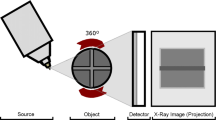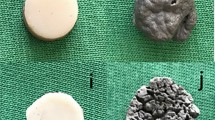Abstract
Today, post-mortem computed tomography (CT) is routinely used for forensic identification. Mobile energy-dispersive X-ray fluorescence (EDXRF) spectroscopy of a dentition is a method of identification that has the potential to be easier and cheaper than CT, although it cannot be used with every dentition. In challenging cases, combining both techniques could facilitate the process of identification and prove to be advantageous over chemical analyses. Nine dental restorative material brands were analyzed using EDXRF spectroscopy. Their differentiability was assessed by comparing each material’s x-ray fluorescence spectrum and then comparing the spectra to previous research investigating differentiability in CT. To verify EDXRF’s precision and accuracy, select dental specimens underwent comparative electron beam excited x-ray spectroscopy (EDS) scans, while the impact of the restorative surface area was studied by scanning a row of dental specimens with varying restorative surface areas (n = 10). EDXRF was able to differentiate all 36 possible pairs of dental filling materials; however, dual-energy CT was only able to differentiate 33 out of 36. The EDS scans showed correlating x-ray fluorescence peaks on the x-ray spectra compared to our EDXRF. In addition, the surface area showed no influence on the differentiability of the dental filling materials. EDXRF has the potential to facilitate corpse identification by differentiating and comparing restorative materials, providing more information compared to post-mortem CT alone. Despite not being able to explicitly identify a brand without a control sample or database, its fast and mobile use could accelerate daily routines or mass victim identification processes. To achieve this goal, further development of EDXRF scanners for this application and further studies evaluating the method within a specific routine need to be performed.




Similar content being viewed by others
References
Carabott R. Dental human identification. In: Adams C, Carabott R, Evans S, editors. Forensic odontology: An essential guide. Chichester: Wiley Blackwell; 2014. p. 65–115.
Lessig R. Forensic odontology. In: Madea B, editor. Handbook of forensic medicine. Oxford: Wiley; 2014. p. 1193–203.
Hausmann R, Liebler M, Schellmann B. Zur Personenidentifikation mittels Zahnstatus. Rechtsmedizin. 1997;7:86–9.
Jackowski C, Aghayev E, Sonnenschein M, Dirnhofer R, Thali MJ. Maximum intensity projection of cranial computed tomography data for dental identification. Int J Legal Med. 2006;120:165–7.
Thali MJ, Markwalder T, Jackowski C, Sonnenschein M, Dirnhofer R. Dental CT imaging as a screening tool for dental profiling: advantages and limitations. J Forensic Sci. 2006;51:113–9.
Jackowski C, Lussi A, Classens M, Kilchoer T, Bolliger S, Aghayev E, et al. Extended CT scale overcomes restoration caused streak artifacts for dental identification in CT--3D color encoded automatic discrimination of dental restorations. J Comput Assist Tomogr. 2006;30:510–3.
Jackowski C, Wyss M, Persson A, Classens M, Thali MJ, Lussi A. Ultra-high-resolution dual-source CT for forensic dental visualization—discrimination of ceramic and composite fillings. Int J Legal Med. 2008;122:301–7.
Kutschy JM, Ampanozi G, Berger N, Ruder TD, Thali MJ, Ebert LC. The applicability of using different energy levels in CT imaging for differentiation or identification of dental restorative materials. Forensic Sci Med Pathol. 2014;10:543–9.
Sakuma A, Saitoh H, Makino Y, Inokuchi G, Hayakawa M, Yajima D, et al. Three-dimensional visualization of composite fillings for dental identification using CT images. Dentomaxillofac Radiol. 2012;41:515–9.
Salzedas LMP, Louzada MJQ, de Oliveira Filho AB. Radiopacity of restorative materials using digital images. J Appl Oral Sci. 2006;14:147–52.
Bush MA, Miller RG, Norrlander AL, Bush PJ. Analytical survey of restorative resins by SEM/EDS and XRF: databases for forensic purposes. J Forensic Sci. 2008;53:419–25.
Bush MA, Miller RG, Prutsman-Pfeiffer J, Bush PJ. Identification through X-ray fluorescence analysis of dental restorative resin materials: a comprehensive study of noncremated, cremated, and processed-cremated individuals. J Forensic Sci. 2007;52:157–65.
MetauxPrecieux Dental GmbH. KATANA TM Zirkoniumdioxid. 2016. http://www.mp-dental-gmbh.de/media/pdf/katana/mpd160096_metanova_materialien_katana_2016_150dpi.pdf. Accessed 04 Jan 2018.
Kaladent AG. UNORAL BIO 1. www.unor.ch/files/unoralbio11.pdf. Accessed 04 Jan 2018.
IvoclarVivadent AG. Tetric EvoFlow® Instructions for Use. 2011. http://www.ivoclarvivadent.com/zoolu-website/media/document/838/Tetric+EvoFlow. Accessed 04 Jan 2018.
IvoclarVivadent AG. Tetric EvoCeram® Instructions for Use. 2011. http://www.ivoclarvivadent.com/zoolu-website/media/document/827/Tetric+EvoCeram. Accessed 04 Jan 2018.
IvoclarVivadent AG. IPS e.max® Press Scientific Documentation. 2011. http://www.ivoclarvivadent.com/zoolu-website/media/document/9808/IPS+e-max+Press. Accessed 04 Jan 2018.
Coltène/Whaledent AG. ORALLOY MAGICAP S Instructions for use. 2010. http://www.elidentgroup.it/store/images/products/file%5COralloyMagiS.pdf. Accessed 04 Jan 2018.
Coltène/Whaledent AG. coltosolcoltosol® F Instructions for use. 2009. https://dvd-dental.com/media/attachments/COLTOSOL-F-12-902.pdf. Accessed 04 Jan 2018.
3M Deutschland GmbH. Cavit™ Instructions for Use. 2015. http://multimedia.3m.com/mws/media/220364O/cavit-temporary-filling-material.pdf. Accessed 04 Jan 2018.
3M Deutschland GmbH. Ketac™ Fil Plus Aplicap™ Instructions for Use. 2014. http://multimedia.3m.com/mws/media/220390O/ketactm-fil-plus-aplicaptm-glass-ionomer-filling-material.pdf. Accessed 04 Jan 2018.
Bearden JA. X-ray wavelengths and X-ray atomic energy levels. U.S. Department of commerce: Washington; 1967.
Beckhoff B, Kanngießer B, Langhoff N, Wedell R, Wolff H. Handbook of practical x-ray fluorescence analysis. Berlin: Springer-Verlag GmbH; 2006.
Acknowledgements
The authors thank Anja Leipner, Claudia Schreiner and Sinjin Joshua Farrance for their contribution and support. The authors also express their gratitude to Emma Louise Kessler, MD for her generous donation to the Zurich Institute of Forensic Medicine, University of Zurich, Switzerland.
Funding
This study did not receive any funding.
Author information
Authors and Affiliations
Corresponding author
Ethics declarations
Conflicts of interest
We know of no conflicts of interest associated with this publication, and there has been no significant financial support for this work that could have influenced its outcome.
Informed consent
Informed consent was obtained from all individual participants included in the study.
Rights and permissions
About this article
Cite this article
Merriam, T., Kaufmann, R., Ebert, L. et al. Differentiation of dental restorative materials combining energy-dispersive X-ray fluorescence spectroscopy and post-mortem CT. Forensic Sci Med Pathol 14, 163–173 (2018). https://doi.org/10.1007/s12024-018-9979-5
Accepted:
Published:
Issue Date:
DOI: https://doi.org/10.1007/s12024-018-9979-5




